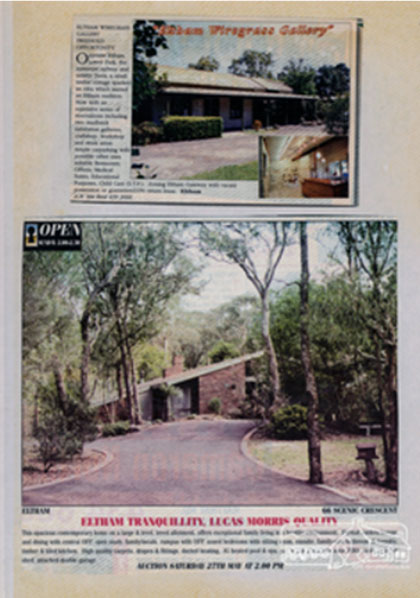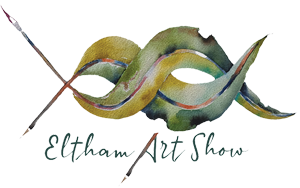Historic Galleries and Associations
Wiregrass Gallery
An original early settler’s cottage, it was built by Mary Jane Smart’s parents, Edwin Bailey and Jane (nee Matthews). Mary Jane Smart was born in the cottage. Artist and cartoonist Percy Leason lived in Eltham during the 1920s and 30s. In recent times the former Leason house, “Landscape” in Lavender Park Road, was home to Margot Tasca who was proprietor of Eltham’s Light Factory Gallery. Margot’s book on Leason details the artist’s life from his childhood in Kaniva in western Victoria through to his death in America in 1959. It is generously illustrated with Leason’s paintings, cartoons and family photos.
Leason thought of himself as a serious artist but is best known for his cartoons including the Wiregrass series in the magazine Table Talk. Many people thought of Wiregrass as representing Kaniva but in fact it was a composite of many country towns. The book tells us that the cartoon Electricity comes to Wiregrass” was produced soon after power came to Eltham.
The book provides a detailed account of Leason’s time in Eltham including the building of “Landscape” and the large studio at the rear of the house. It deals at some length with Leason’s interaction with the local artistic community including members of the Montsalvat artists’ colony. It also deals extensively with Leason’s position in the wider Victorian art scene.
This book, ‘Percy Leason – An Artist’s Life’ by Margot Tasca, published by Thames and Hudson, is an important contribution to local Eltham history and to the history of art in Victoria.

The Light Factory Gallery
Contemporary Australian art does not have a recognisable style, nor is it confined by the iconic movements that have influenced it.
Rather, it is an amalgamation of cultures, identities and stories, reflecting our complex national history. As a result, we are gifted with unique and inspiring works of art that are open to our subjective interpretations.
The Light Factory Gallery is proud to represent living Australian artists whose works continue this country’s legacy to produce versatile works of art. It is our passion to provide all art lovers with the opportunity to own an original work of art. and thus ensure the viability of contemporary Australian art.
The Building
Alistair Knox was a visionary environmental architect working from the 1940s to 1980s, who moved away from the post-war cream brick veneer, laminate kitchens and rose gardens and encouraged people to look at recycled and natural materials and build within a natural landscape. The Light Factory Gallery was built in 1973 and is a classic example of his design. Exposed soaring six metre Oregon beams, handmade bricks, clerestory windows flood the building with natural daylight giving treetop views of the eucalypts that he designed the building around. We are very proud at TLFG to be able to bring to you fine art works in this fine architectural legacy. Opened 2010 closed 2014.
Montsalvat
Montsalvat’s artist-founder, Justus Jorgensen, took his inspiration from the villages of France, but the Montsalvat he built with artist friends and families, notably the prodigiously talented Skipper family, is fashioned out of the clay and stone of this beautiful Eltham hillside, and pieced together with many remnants of Australia’s architectural heritage. Look through the larger bay window in the Upper Gallery and you might learn that it once graced the Victorian Insurance Building. Lean against the great wooden uprights in the Barn Gallery and you will be told they were once wharf timbers from Wollongong.
Montsalvat is one of Australia’s oldest art commune established by Justus Jörgensen after he purchased the land in 1934, Justus was an architect and a passionate artist who wanted to create an environment to help cultivate art and performing arts in his local area.
Justus was born in 1893 in East Brighton and trained as an architect with a Melbourne architectural firm and studied art at the National Gallery School of Art in Melbourne. The principal at the time was Renowned Australian artist Frederick McCubbin a leading member of the Heidelberg School Movement
Artists that worked out of Montsavat were Mervyn Skipper, Arthor Munday, George Charlmers, Leslev Sinclair, Sue Vanderkelen, Ian Robertson. Helen Lempriere, Jonn Smith, John Busst and Myra Skipper, Percy Leaso, Leonard French, Clifton Pugh, Gordon Ford, Joe Hannan and Albert Tucker.
Montsalvat is still very involved in the art community with pottery classes, multiple painting classes, jewelry classes, music performances and art exhibitions, as well they even hold a Montsalvat Film award for the Victorian college of the arts and a Nillumbik Prize For Contemporary Art.
Baldessin Press
George Baldessin had a brilliant career as a sculptor and printmaker, and was already considered an important figure in the history of Australian Art in the 1970s. He won many prizes and every State gallery acquired his work, including his famous Pears sculpture at the NGA Canberra. In 1975 he represented Australia in the Sao Paulo Biennale before living and working in Paris until his return to St Andrews in 1977. He was killed on 9 Aug 1978, aged 39 years, leaving a legacy of work worthy of an artist twice his age.
In 2001 Tess returned to St Andrews to reclaim the very run-down studio and reconstitute it as The Baldessin Press & Studio. It operates in George’s memory, so that artists may continue to create in this special place, thus perpetuating the artist’s generous spirit
Dunmoochin
The Dunmoochin community was established in the early 1950s when a small group of artist friends purchased a bush property in Cottles Bridge, in Melbourne’s north-eastern outskirts. They were following their urge to live a more simple and creative life, in harmony with nature.
The key focus of the Dunmoochin Foundation is to promote arts practice and research, and environmental study, by making the Foundation residential facilities accessible to a broad range of international and Australian practitioners and researchers working in artistic, educational and environmental fields.
Foundation residents can access the Foundation’s art collection, the majority of which is held at La Trobe University under an affiliation agreement.
Dunmoochin derives its cultural and artistic heritage from the collaborative efforts of a group of artists who purchased land in Cottles Bridge in the early 1950’s. These artists pioneered one of the first artistic communes in Australia and created a lasting vision of how a community can gain knowledge and inspiration from living in a close relationship with nature.
One of these artists, Clifton Pugh, achieved national and international recognition during his lifetime and in 1989 he established the Dunmoochin Foundation. Upon his death in 1990 he left an art collection and extensive properties within the Dunmoochin area, to be developed and maintained by the Dunmoochin Foundation.
By preserving its natural and cultural heritage and providing access to its residential properties, studios and art collection, the Dunmoochin Foundation will attract Australian and international artists, environmentalists and scholars and will promote an understanding and appreciation of Australia’s unique bushland and culture.
The Dunmoochin Foundation is administered by a voluntary board that has a high level of arts appreciation and knowledge.
